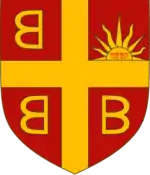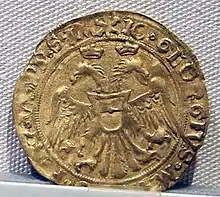Paleologo-Oriundi
The Paleologo-Oriundi are an Italian noble family and a cadet branch of the extinct Palaeologus-Montferrat family, descendants of Flaminio Paleologo, illegitimate son of John George Palaeologus, Marquis of Montferrat 1530–1533. Though they are not part of the Palaeologus-Montferrat family proper on account of their descent from an illegitimate son, they are male-line descendants of the Palaeologus marquises, and by extension the Byzantine imperial Palaiologos dynasty, of which the Palaeologus-Montferrat family was a cadet branch. The Palaeologus-Montferrat family was founded by Theodore Palaiologos, a son of Byzantine Emperor Andronikos II Palaiologos (r. 1282–1328).
| Paleologo-Oriundi Paleologo, Calabraga, Oriundi | |
|---|---|
 Coat of arms of the family, derived from the tetragrammatic cross of the Byzantine Palaiologoi | |
| Parent house | Palaeologus-Montferrat |
| Country | Italy |
| Founded | 1518 |
| Founder | Flaminio Paleologo |
| Current head | Carlo Paleologo-Oriundi |
| Traditions | Roman Catholicism |
| Cadet branches | Quintini-Paleologo (matrilineal; extinct) |
Early members of the family simply used the name Paleologo. The last name Calabraga, originally assumed by a member of the family who was fleeing the law, saw periodical usage in the 16th century. The name Oriundi was first assumed in the late 17th century, "oriundo" meaning an immigrant that is originally of Italian ancestry, a word linguistically related to the term orient (east). The name Oriundi was substituted for the present Paleologo-Oriundi in 1930.
Background

The Palaeologus-Montferrat family was a medieval cadet branch of the Palaiologos dynasty, the last ruling family of the Byzantine Empire. It was created in 1306 when Theodore Palaiologos, fourth son of Byzantine Emperor Andronikos II Palaiologos (r. 1282–1328), inherited the March of Montferrat through his mother, and Andronikos II's second wife, Yolande of Montferrat.[1] Andronikos II's fourth son, rather than one of the older sons, was specifically chosen to not jeopardize the imperial line of succession.[2]
The Byzantine aristocracy were unenthusiastic about the creation of a western cadet branch of the imperial family; that a Byzantine prince, born in the purple, would be sent to live among, and rule over, Latin barbarians,[3] was bad enough but there were also fears that he and his descendants might become 'Latinised'[4] and that the Italians, as a result of the Montferrat inheritance, could launch an invasion in the future in hopes of placing a Catholic Palaiologos on the Byzantine throne.[5] Byzantine fears of Latinisation became true; Theodore converted to Catholicism and on his subsequent visits to Constantinople, Theodore shocked the Byzantines with his shaven face and Western customs.[6]
The Palaeologus-Montferrat family ruled at Montferrat until the 16th century. Though they were sometimes given Greek names, such as Theodore and Sophia,[7] most of the Palaiologan Marquises of Montferrat paid little attention to affairs in the eastern Mediterranean.[8] The only Marquis to seriously consider using his Byzantine connection was Theodore's son, John II of Montferrat, who wished to take advantage of the Byzantine civil war of 1341–1347, between Andronikos II's great-grandson John V (r. 1341–1391) and John VI Kantakouzenos (r. 1347–1354), in order to invade the empire and conquer the city of Thessalonica. In his will from 1372, John II claimed that Andronikos II's deposition in 1328 by his grandson Andronikos III (John V's father, r. 1328–1341) had been unlawful and thus disqualified Andronikos III and all his heirs from the legitimate line of succession to the throne of Byzantium. John II also pointed out that since Andronikos II had disinherited Andronikos III, John II was the rightful emperor as the only true heir to Andronikos II.[6] John II even petitioned the Papacy to recognize his claims to Thessalonica and to the empire, and to help him conquer them.[9] An expedition to "recover" these territories was never organised.[4]
History
Upon the death of John George Palaeologus, the last Marquis of Montferrat of the Palaeologus-Montferrat family, on 30 April 1533, Montferrat was inherited by the Gonzaga family of Mantua.[10] The new marquis, Federico II Gonzaga, was connected to the family by marriage, being the husband of Margaret Paleologa, niece of John George. Federico had married Margaret on 3 October 1531, with the explicit goal of acquiring Montferrat.[11] The deaths of John George and later Margaret did not spell the end for the male-line lineage of the Palaeologus-Montferrat family. John George had an illegitimate son, Flaminio Paleologo, born in 1518, who the marquis had unsuccessfully attempted to have legitimised. Although Flaminio would end his life accused of conspiracy against the Gonzagas, being violently killed in prison on 24 May 1571, he would be survived by seven children.[10] The accusations against Flaminio were true, as he had unsuccessfully worked to overthrow the Gonzagas and gain control of Montferrat.[12] Though Flaminio was illegitimate, his descendants would continue to use the Paleologo name, founding the Paleologo-Oriundi family and representing male-line descendants of the Palaeologus-Montferrat family.[13][14][15] On account of their descent through an illegitimate son, they are not considered part of the Palaeologus-Montferrat family proper.[15]
Flaminio's eldest son, Teodoro (?–1586), was also accused of conspiracy and took refuge in his wife's homeland, Camerano, near Ancona. In order to pass unnoticed, he adopted the fake last name Calabraga, which would periodically be adopted by later members of the family as well.[16] Teodoro's son, Flaminio II (1562–1624), was granted the right to use the title Prince of the Holy Roman Empire by Ferdinand II, Holy Roman Emperor (r. 1619–1637). Flaminio II's great-grandson, Pietro II (1667–1704), was the first to use the name Oriundi, which would be used until it was changed to the present Paleologo-Oriundi through a court ruling in 1930.[16] The word oriundo (of which Oriundi is the plural form) is an Italian noun describing an immigrant that is originally of Italian ancestry, it comes from the Latin oriri and is linguistically related to the term Orient (east).[17]
Four brothers of the Paleologo-Oriundi family—Francesco, Settimio, Ottavio and Noe—died in 1812 fighting for Napoleon in the French invasion of Russia.[18]
The earliest biography published by a member of the family was the work of Federico (1858–1920), great-great-great-grandson of Pietro II, published by his friend J. Chinaki in 1932. Federico's son Arnaldo (?–1939) was a lawyer in Venice and fought in the First World War. He also worked as a historian and wrote extensively on the history of his family, together with his brother Ottorino (1891–1916), their work being published in the Italian heraldic magazine Rivista Araldica.[18] The current head of the family is Arnaldo's son Carlo Paleologo-Oriundi (born 1924), a Venetian banker who lives in Mestre.[19]
There existed a cadet branch of the Paleologo-Oriundi family native to Rome, the Quintini-Paleologo, descended matrilineally from Giuseppe (1792–1861), uncle of Federico. It was founded through the marriage of Giuseppe's granddaughter Ida (1854–1927) and Achille Quintini.[18] Ida and Achille had five children; the son Adolfo (1893–1960) and four daughters.[20][21] Though Adolfo simply used the name Quintini,[21] Adolfo's son Giorgio (1933–2013)[22] assumed the full last name Quintini Paleologo in the 1960s, a name which was not recognised by the Paleologo-Oriundi in Venice, who opposed matrilineal descendants using the Paleologo name.[23] Giorgio was Adolfo's only child[21] and was unmarried and childless.[20] With his death in 2013,[22] this short-lived cadet branch went extinct.[20]
Family tree
Follows Mallat (1990)[15] and Mallat (2007).[24] Heads of the family marked with bold text, women marked with italics.
House of Palaeologus-Montferrat | |||||||||||||||||||||||||||||||||||||||||||||||||||||||||||||||||||||||||||||||||||||
| Flaminio I 1518–1571 | |||||||||||||||||||||||||||||||||||||||||||||||||||||||||||||||||||||||||||||||||||||
| Teodoro I ?–1586 | Giovanni ?–1540 | Ferdinando | Laura | Isabella | Margherita | Eleonora | |||||||||||||||||||||||||||||||||||||||||||||||||||||||||||||||||||||||||||||||
| Flaminio II 1562–1624 | Federico 1566–1608 | A daughter | Bernardino | ||||||||||||||||||||||||||||||||||||||||||||||||||||||||||||||||||||||||||||||||||
| Federico | Pietro I 1582–? | Bonifacio ?–1630 | |||||||||||||||||||||||||||||||||||||||||||||||||||||||||||||||||||||||||||||||||||
| Domenica 1621–? | Biagio I 1622–? | Giovanni 1624–1625 | Bernardo 1624–1633 | Bonifacio fl. 1679 | |||||||||||||||||||||||||||||||||||||||||||||||||||||||||||||||||||||||||||||||||
| Isabella 1666–1712 | Pietro II 1667–1704 | Giambattista fl. 1687 | |||||||||||||||||||||||||||||||||||||||||||||||||||||||||||||||||||||||||||||||||||
| Lucia 1692–1711 | Biagio II ?–1753 | Caterina | Bernardina | Maria Teresa | Silvio ?–1728 | ||||||||||||||||||||||||||||||||||||||||||||||||||||||||||||||||||||||||||||||||
| Pietro III 1719–? | Giovanni Battista ?–1721 | Antonio | Maria Domenica | Maria Elisabetta | Maria Domenica | Tommasa Bernardina | |||||||||||||||||||||||||||||||||||||||||||||||||||||||||||||||||||||||||||||||
| Maria Elisabetta 1743–? | Maria Giovanna 1745–1845 | Michele 1755–1816 | Francesco ?–1812 | Settimio ?–1812 | Ottavio ?–1812 | Noe ?–1812 | Bernardo | Leonardo | Ercolano | Mariano | |||||||||||||||||||||||||||||||||||||||||||||||||||||||||||||||||||||||||||
| Giuseppe 1792–1861 | Andrea 1805–1865 | (Several daughters) | |||||||||||||||||||||||||||||||||||||||||||||||||||||||||||||||||||||||||||||||||||
| Luciano ?–1904 | Federico 1858–1920 | (Nine other children) | |||||||||||||||||||||||||||||||||||||||||||||||||||||||||||||||||||||||||||||||||||
| Ida 1854–1927 | Achille Quintini | Arnaldo ?–1939 | Ottorino 1891–1916 | (One more child) | |||||||||||||||||||||||||||||||||||||||||||||||||||||||||||||||||||||||||||||||||
Quintini-Paleologo family | Teodoro II 1920–1992 | Gabriella 1922–1990 | Carlo b. 1924 | ||||||||||||||||||||||||||||||||||||||||||||||||||||||||||||||||||||||||||||||||||
| Alessandra | Patrizia | Elena | Andrea b. 1952 | Maurizio b. 1956 | |||||||||||||||||||||||||||||||||||||||||||||||||||||||||||||||||||||||||||||||||
| Marco b. 1981 | Carlo b. 1984 | ||||||||||||||||||||||||||||||||||||||||||||||||||||||||||||||||||||||||||||||||||||
References
- Laiou 1968, p. 391.
- Laiou 1968, p. 392.
- Laiou 1968, p. 386.
- Barker 2017, p. 167.
- Laiou 1968, p. 393.
- Laiou 1968, p. 402.
- Dąbrowska 1996, p. 180.
- Barker 2017, p. 168.
- Laiou 1968, p. 403.
- Mallat 2007, p. 4.
- Fenlon 1980, p. 48.
- Berardo & Scarabelli 1847, pp. 400, 419, 433.
- Cassano 2017, pp. 3–9.
- Hernández de la Fuente 2019, p. 252.
- Mallat 1990, p. 60.
- Mallat 2007, pp. 4–5.
- Pianigiani, Ottorino. Dizionario etimologico
- Mallat 2007, p. 6.
- Mallat 2007, p. 7.
- "Giorgio Quintini Paleologo: ROOTS - paternal grandmother IDA QUINTINI PALEOLOGO". Giorgio Quintini Paleologo. 2015-05-10. Retrieved 2020-12-14.
- "Giorgio Quintini Paleologo: ROOTS - Father and Mother". Giorgio Quintini Paleologo. 2015-05-09. Retrieved 2020-12-14.
- "Giorgio Quintini Paleologo: INTRODUCING Giorgio Quintini Paleologo (1933-2013)". Giorgio Quintini Paleologo. 2015-05-08. Retrieved 2020-12-14.
- "Giorgio Quintini Paleologo: QUINTINI or QUINTINI PALEOLOGO?". Giorgio Quintini Paleologo. 2015-05-11. Retrieved 2020-12-14.
- Mallat 2007, pp. 4–7.
Cited bibliography
- Barker, John W. (2017). "Crusading and Matrimony in the Dynastic Policies of Montferrat and Savoy" (PDF). Byzantion Nea Hellás. 36 (36): 157–183. doi:10.4067/S0718-84712017000100157.
- Berardo, Antonio; Scarabelli, Luciano (1847). "Di Una Cronaca Anonima di Casale dal 1530 al 1582 e dell'Assedio di Vercelli del 1617". Archivio Storico Italiano. 13: 335, 337–339, 341–438. JSTOR 44458549.
- Cassano, Gian Paolo (July 2017). "Organo di informazione del Circolo Culturale "I Marchesi del Monferrato" "in attesa di registrazione in Tribunale"" (PDF). Bollettino del Marchesato (in Italian). Cassa di Risparmio di Alessandria. 3 (16): 3–9.
- Dąbrowska, Malgorzata (1996). "Sophia of Montferrat, or The History of One Face" (PDF). Acta Universitatis Lodziensis. 56: 177–194.
- Fenlon, Iain (1980). Music and Patronage in Sixteenth-Century Mantua. Volume 1. Cambridge University Press. OCLC 5832030.
- Hernández de la Fuente, David (2019). "El fin de Constantinopla y las supuestas herencias nobiliarias bizantinas". In Barrios, F.; Alvarado, J. (eds.). Aires de grandeza: Hidalgos presuntos y Nobles de fantasía (in Spanish). Madrid: Dykinson. pp. 245–262. ISBN 978-84-1324-092-3.
- Laiou, A. E. (1968). "A Byzantine Prince Latinized: Theodore Palaeologus, Marquis of Montferrat". Byzantion. 38 (2): 386–410. JSTOR 44169311.
- Mallat, Peter (1990). "The Palaiologos Family After 1453: The Destiny of an Imperial Family". Macedonian Studies. 7: 55–64.
- Mallat, Peter (2007). "I Paleologi di Monferrato dopo il 1533" (PDF). Bollettino del Marchesato (in Italian). 3/4 (16): 4–9.